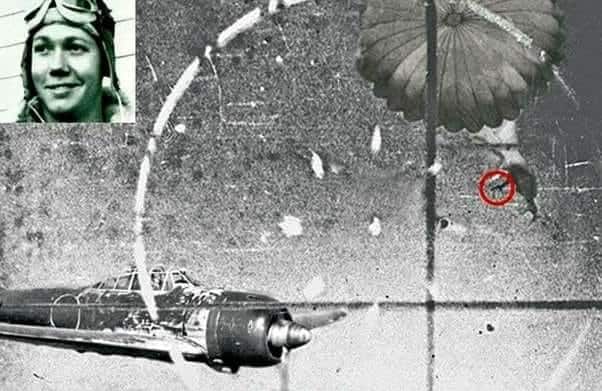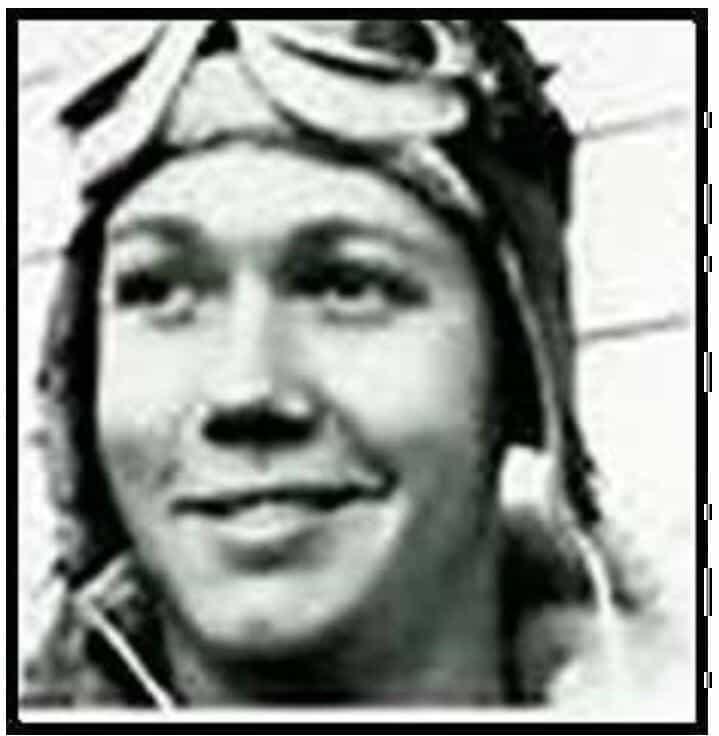Owen John Baggett: The Incredible Story of a WWII Pilot Who Took Down a Japanese Plane with a Handgun

The story of Owen John Baggett is one of the most extraordinary tales from World War II, a testament to the courage and ingenuity of the human spirit. As a young American pilot during the war, Baggett’s survival instincts and quick thinking allowed him to perform one of the most remarkable feats in aviation history—he reportedly shot down a Japanese fighter plane with a handgun while parachuting to the ground.
Let’s delve into the incredible details of Owen John Baggett’s journey, the events leading up to this astonishing act, and how this story continues to inspire today.
Early Life and Military Career
Owen John Baggett was born in 1920 in Texas, USA. Growing up during the Great Depression, he was known for his resilience, a trait that would serve him well during the trials he faced in World War II. Baggett attended Hardin-Simmons University and graduated with a degree in music. However, like many young men of his time, his life would soon be redirected toward military service as the United States entered World War II after the attack on Pearl Harbor in 1941.
Baggett enlisted in the U.S. Army Air Forces and became a pilot. He joined the 7th Bomb Group, flying B-24 Liberators. These heavy bombers were a critical part of the Allied air campaign against Axis powers, and Baggett quickly proved himself to be a capable and skilled aviator. However, his story would take a dramatic turn during a bombing mission over Burma in 1943.

The Fateful Mission
On March 31, 1943, Baggett and his crew were part of a bombing raid over Japanese-occupied Burma. Their mission was to destroy critical infrastructure and supply lines to disrupt the Japanese war effort. Baggett’s B-24, however, was intercepted by Japanese fighters, and in the ensuing battle, the aircraft sustained heavy damage. The bomber, riddled with bullets and on fire, was no longer capable of staying in the air.
As the situation became untenable, Baggett and the crew had no choice but to bail out of the doomed plane. They donned their parachutes and jumped into the sky, hoping to land safely despite being behind enemy lines. What happened next would become the stuff of legend.
Parachuting into Danger
As Baggett descended in his parachute, he found himself in an incredibly dangerous situation. Japanese fighters circled the falling airmen, taking aim at them. These pilots were intent on eliminating any survivors, ensuring no Allied soldiers made it to the ground alive.
Most of Baggett’s crew members were killed by the strafing fire. Baggett himself was injured, but he played dead, allowing his body to hang limp as he drifted toward the earth. This ploy seemed to convince the Japanese pilots that he was no longer a threat.
However, one Japanese pilot, flying low to inspect Baggett’s parachute, made a fatal mistake.
Shooting Down a Japanese Fighter with a Handgun
According to reports from the incident, the Japanese fighter pilot flew close to Baggett to ensure he was truly dead. It was at this moment that Baggett, with his .45 caliber M1911 pistol in hand, took his shot. From his precarious position in midair, Baggett fired at the cockpit of the enemy plane. Astonishingly, he hit the pilot, and the Japanese fighter lost control and crashed to the ground.
This incredible act made Owen John Baggett one of the only people in history—if not the only person—to have ever shot down an enemy aircraft with a handgun while parachuting.
Capture and Survival as a POW
Despite his heroic actions, Baggett was still far from safety. Upon landing, he was captured by Japanese forces and spent the next two years as a prisoner of war (POW) in harsh conditions. The Japanese imprisoned Baggett and other captured airmen in a camp where they were subjected to brutal treatment and near-starvation. Nevertheless, Baggett endured, his resilience and mental fortitude keeping him alive.
During his imprisonment, Baggett and other POWs suffered immense hardships. Food was scarce, and they faced constant abuse at the hands of their captors. Yet, through it all, Baggett remained determined to survive, and he did. He was finally liberated in 1945 when the war came to an end.
The Legacy of Owen John Baggett
Owen John Baggett’s story is an enduring symbol of courage, resourcefulness, and survival against the odds. His ability to remain calm in the face of overwhelming danger and his remarkable achievement of shooting down a Japanese fighter plane with a handgun earned him a place in military legend.
After the war, Baggett continued his service in the U.S. Air Force, eventually retiring as a colonel. He went on to live a full life, passing away in 2006 at the age of 85.
Fact or Legend?
While Baggett’s story has been widely circulated, it’s worth noting that there is some debate about whether or not he truly shot down the Japanese plane. No official records from the Japanese side confirm the downing of the aircraft, and wartime accounts can sometimes be difficult to verify due to the chaos of battle and the lack of detailed documentation.
However, multiple members of Baggett’s unit corroborated his account, and it has since become part of the lore surrounding World War II. Whether fully factual or partly legendary, the tale of Owen John Baggett stands as a testament to the ingenuity and bravery exhibited by soldiers during one of history’s most trying conflicts.
Owen John Baggett’s story is not just a tale of war; it’s a testament to the resilience of the human spirit. His quick thinking, bravery, and remarkable aim in the face of almost certain death make him one of the most extraordinary figures of World War II. Today, his legacy serves as a reminder of the countless unsung heroes who served during the war, each with their own stories of sacrifice, survival, and courage.
Baggett’s tale, though incredible, continues to inspire generations, reinforcing the idea that even in the direst of circumstances, there is always hope, and sometimes, a single well-placed shot can make all the difference.
FAQ: Owen John Baggett’s Story
1. Who was Owen John Baggett?
Owen John Baggett was an American World War II pilot known for an extraordinary story in which he reportedly shot down a Japanese fighter plane with a handgun while parachuting from his damaged B-24 bomber.
2. What made Owen John Baggett famous?
Baggett became famous for allegedly shooting down a Japanese fighter plane with a .45 caliber M1911 pistol while parachuting to the ground after his B-24 bomber was destroyed during a mission over Burma in 1943.
3. Did Owen John Baggett really shoot down a plane with a handgun?
While several members of his unit corroborated Baggett’s account, there are no official records from the Japanese side confirming the incident. This has led to some debate, but his story remains widely accepted as part of World War II lore.
4. What happened to Owen John Baggett after he shot the plane?
After shooting at the plane, Baggett landed safely but was captured by Japanese forces. He spent two years as a prisoner of war (POW) under harsh conditions before being liberated at the end of World War II.
5. How long was Owen John Baggett a POW?
Baggett was a prisoner of war for approximately two years, enduring significant hardship in a Japanese camp before being freed in 1945.
6. What type of aircraft did Owen John Baggett fly?
Owen John Baggett was a co-pilot on a B-24 Liberator, a heavy bomber used extensively by Allied forces during World War II.
7. Where and when did the incident involving Owen John Baggett take place?
The incident occurred on March 31, 1943, during a bombing mission over Japanese-occupied Burma (now Myanmar). Baggett’s B-24 was shot down by Japanese fighter planes during the mission.
8. What happened to the Japanese pilot?
According to Baggett’s account, the Japanese pilot flew close to inspect his parachute and was shot by Baggett. The plane then reportedly lost control and crashed, though no official Japanese records confirm the downing of the plane.
9. Did Owen John Baggett continue his military career after World War II?
Yes, Owen John Baggett continued to serve in the U.S. Air Force after World War II. He eventually retired as a colonel, having had a long and distinguished career.
10. When did Owen John Baggett pass away?
Owen John Baggett passed away in 2006 at the age of 85, leaving behind a legacy as one of the most fascinating figures of World War II aviation history.
11. Is there any debate about the authenticity of Owen John Baggett’s story?
Yes, there is some debate. While many people believe the story and it has been widely circulated, the lack of Japanese documentation confirming the incident has led some historians to question whether it happened exactly as told. Nonetheless, it remains a celebrated part of WWII lore.
12. How is Owen John Baggett remembered today?
Owen John Baggett is remembered as a hero of World War II. His remarkable story is celebrated as an example of incredible bravery, quick thinking, and survival against the odds, inspiring both military personnel and civilians.
